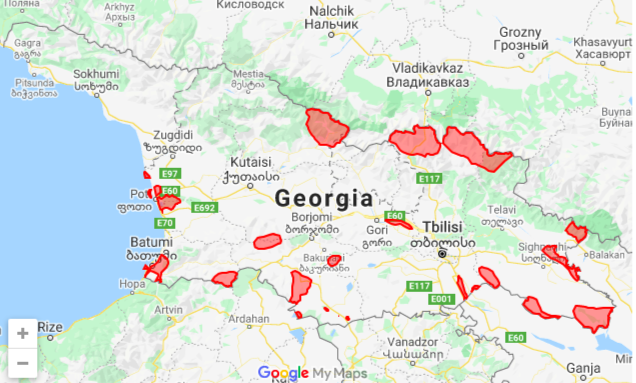Taxonomy
Kingdom Animalia (16266)Phylum Chordata (708)
Class Mammalia (111)
Order Carnivora (18)
Family Ursidae (1)
Genus Ursus (1)
Species Ursus arctos
Browse by taxonomy
Simple search by name
Ursus arctos ✓
Brown Bear, მურა დათვი
Name According To: https://www.iucnredlist.org/species/41688/121229971
Species: arctos
Taxon Rank: Species
Scientific Name Authorship: Linnaeus, 1758
Vernacular Name: Brown Bear
Georgian Name: მურა დათვი
GBD Remarks:
Conservation Status (International): IUCN status (international) LC, ver 3.1 Pop. trend: stable.
Conservation Status (national): Georgian Red List. IUCN National status (2006) EN C2(aI)
Economic importance (national): interesting as an attraction for eco-tourists and scientists. Predation on livestock. Under heavy pressure from poaching. Important character in Georgian national folklore.
Monitoring methods: Surveys (distance sampling, aerial surveys); camera-trapping; genetic analyses; Habitat suitability modeling.
Research activities: (1) ISU, Institute of Ecology, Institute of Zoology; (2) NACRES. contact – Zura Gurielidze, Alexander Gavashlelishvili (ISU), Bejan Lortkipanidze (NACRES). Currently, DNA analyses and studies in bear population genetics are going on at Ilia State University with internal University support. in 2012 aerial and land surveys, conducted by the Institute of Ecology of ILIAUNI, were funded by the government.
Websites: http://nacres.org/lmam03.html
Specific information: During XX century, bears disappeared from floodplain forests and grasslands of southern Georgia and currently are found in mountain forests and savannah-type landscape in Vashlovani reserve (Lortkipanidze, 2010). Lortkipanidze (2010) estimates current population size as 2000-2500 individuals for the entire Southern Caucasus. Lesser and Greater Caucasus populations are matrilineally isolated from one another (Murtskhvaladze et al., 2010). 2012 estimate (Gurielidze 2013; extrapolation of transect counts) suggests ca. 1500-2000 (1600) national population. More detailed information is absent for the country.
Why to monitor: Nationally endangered species, endures heavy pressure of poarching.
Preliminary suggestion: Organize existing data into a user-friendly format freely available on the Internet. Organize annual monitoring at several pre-defined sites throughout Georgia, using camera-traps and collecting scats for genetic studies. Monitoring requires two months per year, an expert and 3-4 students. Holding population genetic studies in the Caucasus region.
კონსერვაციული სტატუსი (საერთაშორისო): IUCN სტატუსი (საერთაშორისო) LC ver 3.1. პოპულაციური ტრენდი: სტაბილური
კონსერვაციული სტატუსი (ეროვნული): საქართველოს წითელი ნუსხა. IUCN ეროვნული სტატუსი (2006) EN C2(aI)
ეკონომიკური მნიშვნელობა (ეროვნული): საინტერესოა ეკოტურიზმისთვის და მეცნიერებისთვის. მოაქვს მცირეოდენი ზარალი სოფლის მეურნეობისათვის ნათესების დაზიანების და მტაცებლობის გამო. ბრაკონიერობის მძიმე წნეხის ქვეშაა. ქართულ ფოლკლორში უკავია მნიშვნელოვანი ადგილი.
მონიტორინგის მეთოდები: აღრიცხვები (დისტანციური სინჯები, საჰაერო აღრიცხვები); მონიტორინგი ფოტოხაფანგების მეშვეობით. პოპულაციის გენეტიკური ანალიზი. ჰაბიტატების მოდელირება.
კვლევები: ილიას სახელმწიფო უნივერსიტეტის ეკოლოგიის ინსტიტუტი, ზოოლოგიის ინსტიტუტი. არასამთავრობო ორგანიზაცია ნაკრესი. საკონტაქტო პირი - ზურაბ გურიელიძე, ალექსანდრე გავაშელიშვილი (ილიას უნივერსიტეტი), ბაჟან ლორთქიფანიძე (ნაკრესი). 2012 წელს სახელმწიფოს დახმარებით აღრიცხვები ჩაატარეს ილიას სახელმწიფო უნივერსიტეტის ეკოლოგიის ინსტიტუტის თანამშრომლებმა. ილიას უნივერსიტეტი რამოდენიმე წელია იკვლევს დათვების პოპულაციურ გენეტიკას მოლეკულურ-გენეტიკური მეთოდების გამოყენებით.
ვებსაიტი: http://nacres.org/lmam03.html
სპეციფიკური ინფორმაცია. მეოცე საუკუნის განმავლობაში დათვი გაქრა წალის ტყიდან და აღარ ცხოვრობს ჯავახეთის ზეგანზე. Lortkipanidze (2010) აფასებს სამხრეთ კავკასიის პოპულაციას 2000-2500 ინდივიდის ფარგლებში. დიდი და მცირე კავკასიონის შორის არ ხდება მდედრი დათვების გადანაცვლება (Murtskhvaladze et al., 2010). 2012 შეფასებით (გურიელიძე 2013; ტრანსექტული აღრიცხვების ექსტრაპოლაცია) ეროვნული პოპულაციის რიცხოვნობა 1500-2000 (1600) აღწევს. უფრო დეტალური ინფორმაცია არ არსებობს.
მონიტორინგის საჭიროება: ეროვნული პოპულაცია მოწყვლადია ბრაკონიერობის გამო.
რეკომენდაცია: არსებული ინფორმაცია სახეობის შესახებ მისაწვდომი უნდა გახდეს ინტერნეტის მეშვეობით. წინასწარ შერჩეული საიტების ყოველწლიური მონიტორინგი ფოტოხაფანგების მეშვეობით. მონიტორინგი შეიძლება ჩაატაროს ექსპერტმა და 3 სტუდენტმა ორი თვის განმავლობაში. გენეტიკური კვლევების გაგრძელება.
Reference of occurrence in Georgia: Bukhnikashvili, A. & Kandaurov, A., 2002. The annotated list of mammals of Georgia. Proceedings of the Institute of Zoology, Tbilisi, XXI: 319-336
Information from GBIF about Ursus arctos
GBIF scientific name: Ursus arctos Linnaeus, 1758
GBIF taxonomic status: ACCEPTED

Conservation Status
This section is under construction
National Red List Status: NT
IUCN Red List Status: LC
Protection status: Not defined
Reason: N/A
Trend: Declining
EOO: 39 300
AOO: 28 116
Native/Introduced: Native
Comment: NT B1 ( საფრთხესთან ახლოს მყოფი) სტატუსი მიენიჭა პოპულაციის გავრცელების ფართობის მიხედვით, რომელიც შედარებით ახლოს არის VU (მოწყვლადის) კრიტერიუმთან, თუმცა მეტია. რიცხოვნობა შეფასდა შეხვედრის წერტილების მიხედვით და შეადგენს დაახლოებით 900-1000 ინდივიდს (გურიელიძე, გამოუქვეყნებელი მონაცემები). ამ რიცხოვნობას შეიძლება მივუსადაგოთ სტატუსი EN (საფრთხეში მყოფი, С კრიტერიუმის მიხედვით). თუმცა, საქართველოში ჰაბიტატის ტევადობის და დათვის საბინადრო ტერიტორიების ფართობების გათვალისწინებით, აგრეთვე ფოტომახეების მიერ გადაღების სიხშირის მიხედვით, ვთვლით, რომ დათვს შეესაბამება სტატუსი „საფრთხესთან ახლოს მყოფი“ (NT) .
Georgian Name: მურა დათვი
English Name: Brown Bear
Taxonomy according to: https://www.iucnredlist.org/species/41688/121229971
References: Dahle B. Swenson J.E. 2003. Home ranges in adult Scandinavian brown bears (Ursus arctos): effect of mass, sex, reproductive category, population density and habitat type. Journal of Zoology; Retrieved by ttps://zslpublications.onlinelibrary.wiley.com/doi/
Evaluated By: Kopaliani N, Gurielidze Z
Date evaluated: Nov 2021





